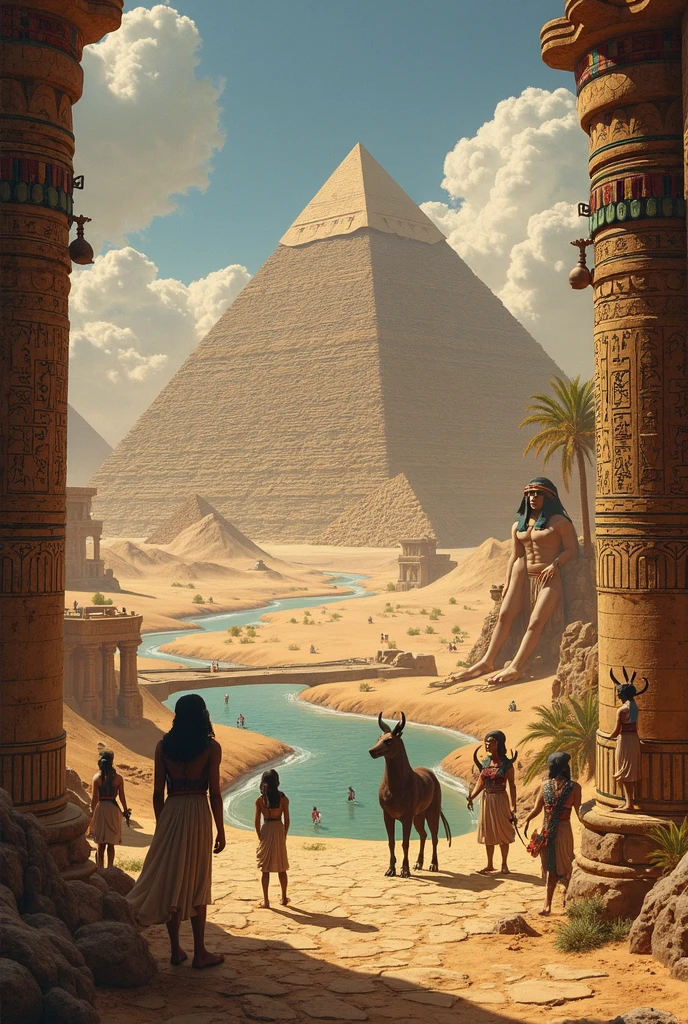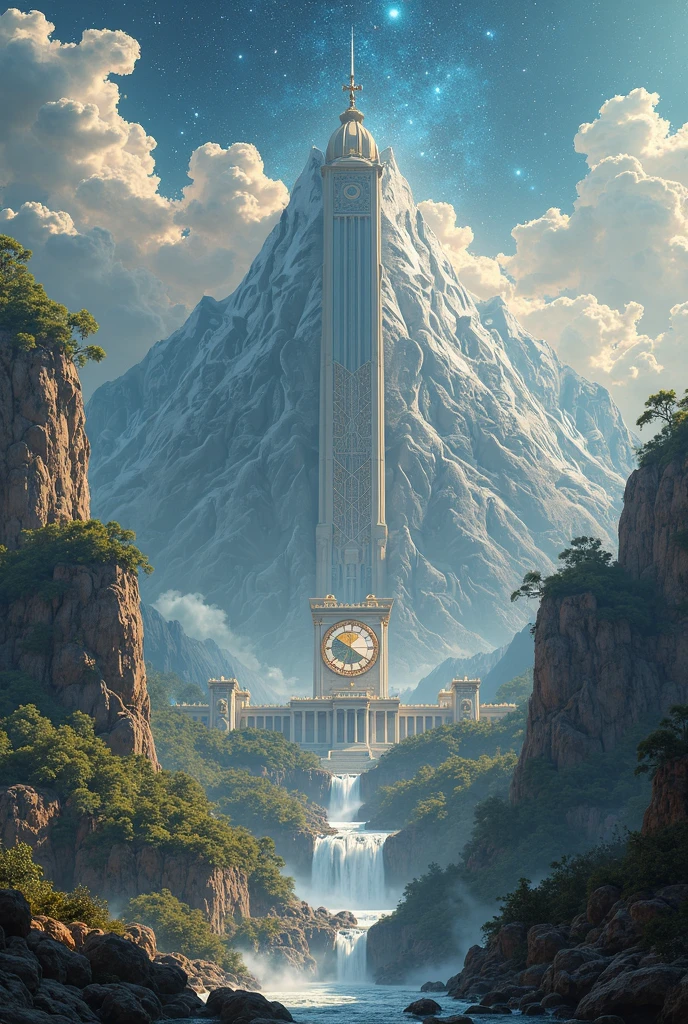Tatar Mythology: The Cosmic Realm of Ülgen
The rich tapestry of Tatar mythology weaves together ancient beliefs, celestial deities, and shamanic traditions. At the heart of this spiritual cosmos stands Ülgen, the supreme god of the sky and light, revered as the creator of the world. This article explores the fascinating legends surrounding Ülgen, his role in creation, and his connection to shamans and elvish beings in Tatar folklore.
Who is Ülgen?
Ülgen is the highest deity in Tatar mythology, often depicted as a benevolent ruler of the heavens. He embodies purity, wisdom, and the life-giving power of the sky. Unlike darker deities, Ülgen represents order, justice, and the divine light that nurtures all existence.
Attributes of Ülgen
- Creator of the World: Ülgen shaped the earth, sky, and all living beings.
- Lord of Light: He governs the sun, moon, and stars, ensuring cosmic harmony.
- Protector of Shamans: Shamans invoke Ülgen for guidance and blessings.
- Opposer of Evil: He battles Erlik, the god of the underworld, to maintain balance.
The Creation Myth
According to Tatar legends, Ülgen crafted the universe from primordial chaos. Floating on the waters of nothingness, he summoned the earth to rise and commanded the sky to stretch infinitely above. His breath became the wind, and his voice shaped the mountains and rivers.
| Element | Ülgen’s Role |
|---|---|
| Earth | Formed from clay and divine will |
| Sky | Stretched as a canopy of light |
| Humans | Created from birch trees and blessed with souls |
Ülgen and the Shamans
In Tatar tradition, shamans act as intermediaries between humans and Ülgen. Through rituals and trances, they ascend the World Tree to seek his wisdom. Ülgen grants them healing powers, prophetic visions, and protection against dark forces.
The Shamanic Journey
- The shaman enters a trance, often aided by drumming.
- Their spirit climbs the celestial tree, passing through seven or nine heavens.
- Upon reaching Ülgen’s realm, they receive divine messages.
- The shaman returns to earth to share Ülgen’s guidance.
Elvish Beings in Tatar Mythology
Tatar myths speak of elvish spirits known as “Yöräklär,” who serve Ülgen as messengers and guardians. These ethereal beings dwell in forests, mountains, and rivers, embodying the purity of nature. Unlike Western elves, Yöräklär are more akin to luminous spirits tied to the sky and light.
Types of Yöräklär
- Ak Yöräk: White spirits of the heavens, allies of Ülgen.
- Kara Yöräk: Dark spirits serving Erlik, the underworld god.
- Su Yöräklär: Water spirits who protect sacred springs.
Ülgen in Modern Culture
Today, Ülgen remains a symbol of hope and divine order in Tatar culture. His legacy lives on in folk songs, shamanic revivals, and artistic depictions. Scholars compare him to other sky gods like Tengri in Turkic mythology or Zeus in Greek myths.
For further reading, explore these resources: Turkic Peoples Encyclopedia, Shamanism in World History, Central Asian Mythology at The Met.
Discover more captivating myths and legends on our website, and join our community on facebook.com/zatiandrops for daily updates!
Beyond his role as the supreme creator, Ülgen governs a structured pantheon of lesser deities and spirits. This celestial hierarchy reflects the Tatar worldview, where every natural phenomenon has a divine overseer. The most prominent figures in Ülgen’s court include:
| Deity | Domain | Symbol |
|---|---|---|
| Koyaş | Sun | Golden disk with radiating beams |
| Ay Ata | Moon | Silver crescent |
| Yel Ana | Wind | Invisible breath carrying seeds |
| Su Iyesi | Water | Rippling blue veil |
Koyaş: The Solar Guardian
As Ülgen’s foremost lieutenant, Koyaş drives the sun across the sky in a chariot of fire. Tatars believed solar eclipses occurred when Koyaş battled serpentine demons attempting to devour the sun. Rituals involving mirrors and copper plates were performed to reflect light and aid the deity.
Solar Festivals in Tatar Tradition
- Nardugan: Celebrated during the winter solstice, marking the sun’s rebirth.
- Sabantuy: A summer festival honoring Koyaş’s life-giving energy.
- Karga Botkasy: Ritual bread offerings to ensure the sun’s return.
While Ülgen rules the heavens, his shadowy brother Erlik governs the subterranean realm of the dead. Ancient myths describe Erlik’s rebellion—his attempt to usurp Ülgen’s throne, which led to his banishment underground. This duality mirrors the eternal struggle between light and darkness.
The Seven Layers of the Underworld
According to shamanic lore, Erlik’s domain consists of seven progressively darker layers, each inhabited by twisted spirits:
- Kara-Khan: A marshland where souls linger before judgment.
- Temir-Kapik: The “Iron Gate,” guarded by Erlik’s hounds.
- Körküt: A desert of illusions that tests the dead.
- Uçmak: A false paradise trapping greedy souls.
- Tamag: A volcanic pit punishing oath-breakers.
- Kutup: The abyss of forgotten ancestors.
- Erlik Khan’s Palace: The final court where souls are weighed.
Animals play pivotal roles as Ülgen’s emissaries and protectors. Certain species are considered sacred due to their celestial associations or shamanic symbolism.
The White Mare: Ülgen’s Steed
In rituals, shamans invoke the Ak Buğra (White Mare), a divine horse that carries prayers to the sky. Its milk symbolizes purity, and its mane is said to contain strands of starlight. Tatars historically sacrificed white horses during solstice ceremonies, releasing their souls as messengers to Ülgen.
Other Revered Creatures
- Bürküt (Eagle): Ülgen’s eyes, soaring between earth and heaven.
- Bars (Snow Leopard): A guardian of mountain passes.
- Yılan (Serpent): Ambivalent beings representing both wisdom (white serpents) and Erlik’s deceit (black serpents).
Central to Tatar mythology is the Bai-Terek, a colossal tree connecting the three realms: Ülgen’s sky (upper world), the human earth (middle world), and Erlik’s underworld. Its roots dig into darkness, while its branches cradle the stars.
Symbolism of the Bai-Terek
| Part of the Tree | Symbolic Meaning |
|---|---|
| Roots | Ancestral memory and the underworld |
| Trunk | Humanity’s present existence |
| Branches | Ülgen’s celestial kingdom |
| Leaves | Souls awaiting rebirth |
To honor Ülgen, Tatars performed elaborate rites, often led by shamans. These rituals ensured harmony between humans and the divine.
The Spring Blessing Ceremony
During Jiyren, communities gathered at high altitudes to:
- Light bonfires using nine types of wood.
- Tie ribbons (chalama) to birch trees as prayers.
- Sacrifice a white lamb, its smoke carrying wishes skyward.
Traditional Offerings
- Kumis (Fermented Mare’s Milk): Poured onto the earth as libation.
- Round Bread (Kölgä): Symbolizing the sun’s cyclical journey.
- Blue and White Cloth: Representing the sky and clouds.
Tatars interpreted natural phenomena as Ülgen’s communications. Certain signs held deep prophetic significance:
Celestial Omens
- Shooting Stars: Believed to be Ülgen’s tears for human suffering.
- Rainbows: Bridges for shamans traveling between worlds.
- Northern Lights: The shimmering armor of sky warriors.
For deeper insights, consult these resources: Tengri and Altaic Deities, Siberian Mythology Texts, Global Folklore Database.
Discover more captivating myths and legends on our website, and join our community on facebook.com/zatiandrops for daily updates!
In Tatar cosmology, Ülgen’s voice was believed to manifest through sacred sounds and vibrations. Shamans used specific chants called algysh to communicate with the sky god, each syllable carrying cosmic significance. These invocations weren’t merely prayers but living threads connecting the earthly and divine realms.
The Power of Sacred Words
According to ancient Tatar shamans, Ülgen’s language operated on three levels:
| Level | Manifestation | Purpose |
|---|---|---|
| Kük | Celestial hymns | Praising Ülgen’s glory |
| Yer | Earthly commands | Healing and protection |
| Yöräk | Spirit whispers | Divination and prophecy |
Musical Instruments of the Gods
Shamans used specialized instruments to replicate Ülgen’s divine frequencies:
- Kubyz: A jaw harp producing “sky vibrations”
- Dombra: A two-stringed lute for storytelling prayers
- Davul: Ceremonial drums with horsehide membranes
Tatar timekeeping was deeply intertwined with Ülgen’s cosmic cycles. Their calendar divided the year into sacred periods governed by celestial events and mythological occurrences.
Major Mythological Dates
- Tengrian New Year (March 21): Celebration of Ülgen awakening nature
- Summer Solstice (June 21): Peak of Koyaş’s power
- Ülgen’s Silence (October 31-November 7): When the god withdraws to judge souls
Astronomical Markers
Tatars observed specific constellations as Ülgen’s “heavenly script”:
- Ursa Major: Ülgen’s hunting bow
- Orion’s Belt: The three nails holding up the sky
- Pleiades: The seven daughters of Ay Ata
Numerology played a crucial role in Tatar mythology, with certain numbers holding special significance in Ülgen’s cosmic order.
| Number | Mythological Meaning | Ritual Applications |
|---|---|---|
| 3 | Divine trinity (Ülgen, Earth, Underworld) | Circumambulations around sacred fires |
| 7 | Heavens in shamanic cosmology | Steps in initiation rituals |
| 9 | Completeness of creation | Knots in protective talismans |
| 40 | Sacred period of transformation | Days of shamanic training |
Archaeological evidence suggests ancient Tatars built open-air sanctuaries to honor Ülgen. These sacred spaces followed precise astronomical alignments and incorporated natural elements.
Characteristics of Ülgen Temples
- Circular stone formations mirroring the sun’s path
- Birch groves as living temples
- Mountain top altars with eastern orientations
- Water mirrors to reflect celestial bodies
Recent Discoveries
Excavations in the Volga region have revealed:
- A 12th century shamanic ritual complex with 9 concentric circles
- Petroglyphs depicting Ülgen’s chariot
- Ceramic vessels with astral symbols
Beyond the well-known Yöräklär spirits, Tatar mythology mentions several lesser-known divine beings in Ülgen’s service.
Minor Deities of the Pantheon
| Name | Domain | Appearance |
|---|---|---|
| Chulpan | Morning star | Youth with golden hair |
| Säskä | Dew | Transparent maiden |
| Boldyr | Echo | Invisible messenger |
For further exploration of these fascinating traditions, visit: Siberian Mythology Archive, Turkic Deities Encyclopedia, Central Asian Art Collection.
Discover more captivating myths and legends on our website, and join our community on facebook.com/zatiandrops for daily updates!
In Tatar shamanic practice, specific ritual objects served as conduits to Ülgen’s realm. These sacred implements were believed to contain fragments of celestial power, carefully crafted according to ancient prescriptions.
Essential Shamanic Instruments
| Tool | Material | Spiritual Function |
|---|---|---|
| Orba (Drum) | Larch wood, horsehide | Vehicle for astral travel |
| Yada (Stone) | Meteoric iron | Weather control talisman |
| Bilezik (Bracelet) | Silver with wolf motifs | Protection against Erlik’s spirits |
The Making of a Sacred Drum
Creating an orba involved elaborate rituals mirroring Ülgen’s creation of the world:
- Selecting a tree during the waxing moon
- Carving cosmic symbols while chanting
- Stretching the hide of a ritually sacrificed white horse
- Consecrating with smoke from juniper branches
The Tatar cosmos envisioned Ülgen’s kingdom as a series of layered heavens, each with distinct characteristics and divine inhabitants. Shamans described these realms in vivid detail during their visionary journeys.
The Nine Heavens of Tatar Cosmology
- 1st Heaven: Realm of clouds and weather spirits
- 3rd Heaven: Abode of ancestral protector spirits
- 5th Heaven: Treasury of unborn souls
- 7th Heaven: Hall of divine judgment
- 9th Heaven: Ülgen’s golden palace
Notable Celestial Landmarks
| Location | Description |
|---|---|
| Ak Bulak | White spring of eternal life |
| Kök Köprü | Rainbow bridge to higher realms |
| Altyn Tagh | Golden mountain of prophecy |
Beyond the Yöräklär spirits, Tatar lore speaks of magnificent beasts serving as Ülgen’s guardians. These creatures often appeared in shamanic visions and folk tales as omens or protectors.
Legendary Protectors
- Samruk: A giant two-headed eagle nesting in the World Tree
- Tulpar: Winged horses carrying prayers to heaven
- Barys: Snow leopards with star-marked fur
Characteristics of Divine Beasts
| Creature | Symbolism | Shamanic Association |
|---|---|---|
| Samruk | Cosmic balance | Upper world journeys |
| Tulpar | Soul transportation | Funerary rites |
| Barys | Mountain wisdom | Initiation visions |
Certain flora held special significance in Tatar mythology, believed to contain fragments of divine essence. These plants featured prominently in rituals and medicinal practices.
Botanical Sanctity
- Birch (Kaiyn): The world tree’s earthly manifestation
- Juniper (Archa): Purifying smoke for ceremonies
- Edelweiss (Altyn Gül): Symbol of celestial purity
Ritual Uses of Sacred Plants
- Birch bark inscriptions of prayers
- Juniper branches for sweeping negative energy
- Edelweiss garlands during solstice celebrations
For deeper exploration of these traditions, visit: Siberian Mythology Texts, Shamanic Practices Worldwide, Central Asian Cultural History.
Discover more captivating myths and legends on our website, and join our community on facebook.com/zatiandrops for daily updates!
The Language of Ülgen: Sacred Scripts and Symbols
Ancient Tatars believed Ülgen communicated through a celestial alphabet known as Kök Tamga (Sky Signs). These mystical symbols appeared in natural phenomena and were interpreted by shamans as divine messages.
Key Elements of Kök Tamga
| Symbol | Meaning | Manifestation |
|---|---|---|
| ☀ | Ülgen’s eternal presence | Sun halos |
| 𐰃 (Vertical line) | World Tree connection | Lightning strikes |
| 𐰖 (Horned symbol) | Divine protection | Mountain silhouettes |
Shamanic Vision Quests
To receive Ülgen’s wisdom, aspiring shamans underwent rigorous initiation trials that tested their connection to the spirit world.
- Three-day isolation in mountain caves
- Dream fasting to induce visions
- Elemental challenges (fire walking, ice submersion)
- Spirit naming ceremony where Ülgen revealed their true shamanic identity
Visionary Symbols and Their Meanings
- White wolf: Sign of chosen status
- Falling stars: Purging of past lives
- Golden threads: Connection to celestial realms
Ülgen’s Celestial Calendar
The Tatar Moon-Sun calendar tracked Ülgen’s sacred cycles through 12 animal signs and 9 elemental phases.
| Month | Animal Sign | Elemental Phase |
|---|---|---|
| March | Snow Leopard | Awakening Earth |
| June | Golden Eagle | Fiery Sky |
| September | Spirit Horse | Wind Messenger |
Sacred Geography: Ülgen’s Earthly Thrones
Certain mountains were venerated as earthly manifestations of Ülgen’s power, where the boundary between worlds grew thin.
- Belenkey Tau (White Mountain): Site of annual sky offerings
- Kara Tau (Black Mountain): Shamanic vision quest location
- Altyn Shoky (Golden Peak): Legendary home of celestial messengers
Mountain Pilgrimage Rituals
- Circumambulation (3, 7 or 9 circles)
- Stone cairn offerings
- Sky cloth (kök jazy) tying ceremonies
For deeper exploration of Tatar traditions, visit: Siberian Shamanic Texts, Turkic Mythology Encyclopedia, Central Asian Artifacts.
Discover more captivating myths and legends on our website, and join our community on facebook.com/zatiandrops for daily updates!


